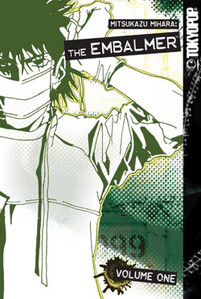Review
by Melissa Harper,The Embalmer
GN 1
| Synopsis: |  |
||
In Japan, the practice of embalming is looked at with anything from skepticism to downright disgust. It is considered garish and unsanitary. The Embalmer takes an episodic look at the prejudice, pain, dangers, and joys that face a young man who goes against the grain to practice this taboo art. |
|||
| Review: | |||
A worthwhile and insightful read, volume one of The Embalmer certainly isn't going to jump off the shelf at anyone. The title alone is enough to turn many readers away; those that pick it up would probably only do so out of morbid curiosity. If they did, the front cover continues the original impression, splashed in sickly colors of yellow, green, and black, zigzagged with stitches, featuring a dark, wild young man wearing a surgical mask. Interestingly, all these surface details hide a surprisingly bittersweet, insightful cache of stories about the everyday tragedies in life, and the people who are affected by them, told through someone who sees it all, an embalmer. The definite highlight of this first volume is the amount of heart and detail given in each of the individual episodes that it is divided into. Each one deals with a different “patient” of the titular embalmer, Shinjyurou Mamiya, and each is its own “slice of life” story. In each of these there is a death, which holds special circumstances that Shinjyurou must deal with in bringing peace to the families or to the victims themselves. In one, a promising ballerina has a leg severed, but her fiancé wants her to be in her dance costume for the funeral. Another has a man die of a contagious disease when his last wish was to be able to hold his son one more time. These stories are moving on their own, but as each one is woven together through the eyes of Shinjyurou, they complement each other even more. The character designs are very distinctive, with a spiky, thick style. Each character is easily distinguishable from the others, with plenty of detail in everything from their faces to their clothing to their hairstyles. Most of the characters are also unexpectedly deep, even the characters that only appear on a couple of pages. It is amazing how real these characters seem for the small amount of time that they appear. Most notable is the father with the disease, who only has a two-page appearance, but is completely developed as a loving father and husband, a hard-worker, and someone with an amazing level of devotion to his family. In contrast, the two recurring characters, The Embalmer and his landlady, are rather poorly fleshed out. It seems that Mihara is holding off developing these characters until later volumes, leaving the reader to feel out the characters as they react to the events of the story. While this is not a bad device to use, it still leaves the characters a little hollow, especially the landlady, Azuki. Her relationship with Shinjyurou is very ambiguous. The reader is unsure whether she is in love with him or not; his feelings for her are likewise vague. There is almost no insight given to her character at all. There is a definite lack of background on these characters, and at the end of the book you feel more for the kid who only had eight pages than the main character of the story. On the positive side, the lack of information peaks curiosity a bit. One wonders how Shinjyurou got into embalming, why he seems so lonely, even why he lives in a church. It generates interest in the next volume to be sure, but at the cost of the current one. The art style is appropriately dark and edgy for a story about death, with lots of dark lines and smudges, and sharp points and angles. Sometimes the darkness is a little too much, though, especially in a few places where it obscures the text. In all, it looks very good, and symbols are used to great effect; especially outstanding is the recurring clock in the second chapter. The panels are clean and well-laid out, so it is rarely confusing, and mostly smooth to read. One very nice thing about this volume is the way that everything is explained so clearly. Done differently, the book might be too culturally different for English-speaking audiences to understand, but it never feels that way. The prejudice against embalming, and the reasons behind it, why it is dangerous to be an embalmer in Japan, all these things are made clear, either through logical events in the story, or through dictionary-style splashes that are dispersed through the volume. It's an odd little story with strikingly different art, but don't discount it because it doesn't look like something you would typically check out. The depth of the characters, the vibrancy of the art, and the detail given in the story are all excellent reasons to read The Embalmer. It sounds gruesome, and some of it is, but the value of the insight in it far outweighs any negatives. |
|
The views and opinions expressed in this article are solely those of the author(s) and do not necessarily represent the views of Anime News Network, its employees, owners, or sponsors.
|
| Grade: | |||
Overall : B+
Story : A
Art : B
+ Each individual story is gripping in its detail; art is different and interesting, as are the character designs. |
|||
| discuss this in the forum (7 posts) | | |||
| Production Info: | ||
|
Full encyclopedia details about Release information about |
||